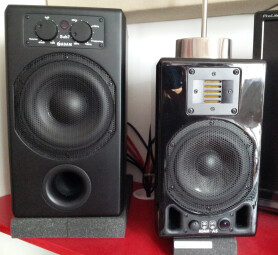The time has come to buy a pair of monitors for your home studio, but you don't know which ones you should choose? Do's and don'ts.
Budget
The first thing to take into account is your budget. Even if you can find speakers for $50 a pair, they shouldn’t be considered real monitoring speakers, but rather “multimedia” speakers. Affordable and serious options start at around $100–150/unit. If you have enough money, don’t hesitate to buy quality monitor speakers ($1000/pair and up) and don’t spare on the main elements of your home studio. They will allow objective listening, which is crucial!
Active or passive?
We recommend you to choose active speakers ─ with integrated amplification, that is ─ for several reasons. Convenience: since the speaker hosts the amps, you have more free space, which is important in most home studios. Moreover, these amps are perfectly matched to the transducers (tweeter, woofer, etc.) of the speaker. Connections are also simpler: you simply have to connect your audio interface or mixer directly to the speakers with standard audio cables.
Size does matter, indeed
With monitor speakers, large dimensions don’t actually mean better quality. Although speakers with a large woofer usually reach lower frequencies, the latter can be counterproductive in a small room. If your room is small, we recommend you to buy 5" or 6.5" monitors and, whenever needed, to use a pair of headphones to monitor the low-frequency range. A speaker equipped with an 8" or larger woofer requires a big room, otherwise it won’t work to full capacity and the distance between the speakers and the sweet spot will be too short. If your budget and the size of your studio are limited, choose a compact 2-way speaker.
Further details to consider
Some monitor speakers offer wall-mounting options, which can be very useful in small rooms. If you still have a CRT screen, choose a magnetically shielded speaker.
The speakers may provide additional features like a volume control and/or power switch on the front panel, auto-bypass, etc…
The type of tweeter is not as important as you might think and you can find good-sounding tweeters in all three categories: ribbon, silk dome and inverted dome. Rely on your ears (or the ears of someone else) instead of on the specs or the technology itself.
The control settings available (filters, EQ) play an important role if your room was not treated acoustically: the more you get, the more you’ll be able to compensate for acoustic problems.
Don’t forget
Speaker connection cables should be included in your budget: XLR or TRS cables for balanced connections, RCA cables for unbalanced connections in case your audio interface has no balanced outputs. And also consider purchasing speaker foam pads (sold from $30/pair and up) or, even better, speaker stands (from $50 upwards).

